Knafeh…the crown jewel of Palestine, the pinnacle of Levantine desserts, one only needs to utter the word “knafeh” to anyone in the know and you immediately gather from their reaction we are talking about something really special here. Just one bite alone of the hot, sweet, salty, gooey, crunchy, perfumed seduction will make you fall in love with the Middle East. There are many versions of knafeh laboriously prepared throughout the Levant, but the knafeh to be reckoned with, the knafeh not to be missed, comes from Nablus, Palestine. Other cities present strong contenders however – I devoured a mean knafeh in Nazareth – following the intoxicating aromas of baking knafeh led me down desolate narrow streets to beautiful trays of the coveted delight in the old market in Khalil – and lines around the block gather every evening in Amman, Jordan with regular patrons hoping to score a sizzling slice from Habiba Knafeh. I’ve heard wonderful things about the knafeh from Lebanon and Syria as well.
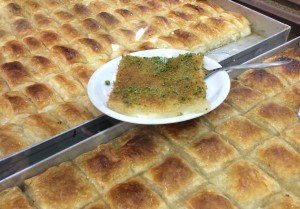
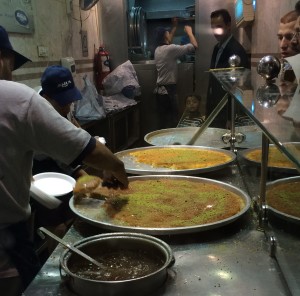
However, the best knafeh I ate was in the small Palestinian village of Tur’an, at my friend Vera’s family home, whose family I’d promised to visit while I was traveling across Palestine. Her mother cried when I arrived and we hugged, and I informed her that the last hug in particular was from her daughter back in the states. Eagerly anticipating my visit, her mother must have prepared at least 14 different delicious dishes for dinner, and insisted I have two helpings of each one, not unusual in keeping with legendary Palestinian hospitality. I instantly felt like part of her family and throughout the evening I observed in each family member different yet unmistakable elements of Vera’s personality.
After dinner playing with the kids, looking at old photos, skyping with Vera, our conversation turned more solemn as we exchanged somber stories of their life in Palestine throughout the years and the incomprehensible things I witnessed my first week there, including the trial it was to even make it to Tur’an that day. As we chatted, our bellies still stuffed to the brim, I hadn’t even noticed her dad had slipped out of the apartment until he returned smiling carrying a bakery box. Inside the box, still piping hot, wafts of toasted golden deliciousness, melted cheese and orange blossoms taunted my nose while her dad and mom beamed with pride upon learning this would in fact be the first slice of knafeh I would eat in Palestine.
It was nothing short of what knafeh dreams are made of, but perhaps it was sweetened a tad by the sentimental moments I shared with her family that evening that I will forever cherish. As we savored every last bite, washing it down with shai maramiya (sage tea), I lamented about not being able to stay longer having to make a long late-night trek through back roads back to Jerusalem. Before I left they gave me a CD of the honored national poet Samih Al-Qasim, who had passed away just a few weeks before, while they made clear I always had a welcoming home there awaiting my return.
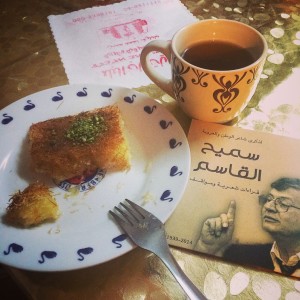
I don’t think there is any home recipe that can replace the experience of enjoying a slice of knafeh fresh on the street, complete with the sounds of tantalizing sizzles as ladels of hot syrup are poured atop, but here is my best version that is beginning to earn me a little reputation in Washington, DC. Some recipes call for using kataifi (shredded phyllo) pastry, I prefer the Nabulsi style made with semolina (“smeed” in Arabic). It takes a bit longer but it is more authenic, holds up to the hot syrup better, and is so worth it!
For the semolina (smeed) crust:
3 cups semolina (“smeed” in Arabic) – use 1 cup of coarse and 2 cups fine for best texture
2 sticks butter or 1 cup of ghee (ghee will provide a more authentic flavor)
1/2 cup water
1/4 cup orange blossom water
1/4 cup rose water
1/2 cup sugar
1/4 teaspoon sea salt
Preheat oven to 350 degrees. Bring the water, orange blossom water, rose water, sugar, salt and butter (or ghee) to a boil in a large saucepan. Once it comes to a boil, add the semolina. Stir constantly on medium heat for about 2 minutes. Remove from heat. Spread the mixture evenly on a large sheet pan with at least 1/2 inch sides (or use a 9×13 cake pan or anything that will allow the mixture to spread out to about half an inch). Bake at 350 degrees for about 10-15 minutes, just until it is firm but not yet browning. Remove from oven and let cool. Flip over on a clean surface and break into large chunks to be milled into fine crumbs. You can do this one of two ways: (1) with your hands, rub together large pieces between your palms until it is all fine crumbs; or (2) place the large chunks into a food processor and pulse a few times until all fine crumbs – this is a lot faster, but I prefer to do it with my hands when time permits. You now have the proper crust for knafeh. You can make this ahead of time and keep in fridge or freezer. I make sometimes a double batch and keep leftovers in freezer and then you are always ready to make knafeh!
To make the knafeh:
1 batch semolina crust crumbs (recipe above)
1 lb akawi cheese shredded, crumbled, or cut into 1/4 or less slices – should be about 2 cups (see note on cheese)
Akawi cheese is a semi-salty Palestinian farmer cheese (named for the city of Acre). You can find it in some Arab or middle eastern groceries. There are also Syrian and Lebanese versions of it. I’ve also used Syrian cheese (its literally called “Syrian cheese”) and had good results, its a little salty, which I think makes for a tastier knafeh as it contrasts nicely against the sweet syrup and crunchy, sticky semolina crust. Some recipes I’ve read call for soaking saltier farmer cheeses in water and changing water a few times to draw out the salt. I think this is nonsense! But do what you like 😉 I’ve had great results also using Oaxaca cheese (a Mexican handmade string cheese that melts nicely – available in Latin markets). I’ve also done this using various combinations of several cheeses above and melting together in a saucepan first with a few tablespoons of cream and tablespoon of semolina, sometimes adding some ricotta, or cheese curds (as shown in photo below). But if you like a stringy, melty cheese, do not do this. Both ways are goods, its a preference of texture. Mozzarella can also be used as a last resort, but try to locate the real Arab cheeses its worth it!
To assemble the knafeh, take a bit more than half of the semolina crumbs and evenly sprinkle, covering the entire bottom of a well-greased (use butter or ghee only) round baking pan, 16 to 18 inches. You can use a sheet pan also. Press the crumbs firmly into the bottom of the pan. Press crumbs into the sides of pan for a nicer presentation with neat sides. Layer the cheese shreds/crumbs/slices evenly -or- pour melted cheese (if you used this method) on top of the pressed crumbs. Sprinkle the remaining semolina crumbs evenly over top of cheese and press down lightly. Bake knafeh in a 350 degree oven for about 45 minutes or until the semolina crumbs on the top are starting to look golden and it looks a bit bubbly. Your kitchen should smell amazing by now!
While knafeh is baking, make the attar syrup:
In a small sauce pan, whisk 1 cup of sugar with 3/4 water and 2 tablespoons of rose water and 2 tablespoons of orange blossom water. You can vary the proportions of rose and orange blossom water to your taste. You can also add in a tablespoon of fresh lemon juice. Just try to stick the rule of 1 cup sugar to 1 cup water ratio. Boil on medium heat stirring frequently until sugar is dissolved and syrup begins to thicken. The whole process takes about 6-8 minutes. Don’t let it get too thick or start to brown, you want it thin to pour over the hot knafeh, no thicker than maple syrup.
Check on your knafe! Once the semolina crumbs are looking golden, remove from oven, let cool only about 5 minutes. Run a knife around the side of the pan to loosen. Then place your serving dish on top of pan and quickly but carefully flip over using potholders of course. Once flipped over give the pan a good tap in the middle. Carefully lift up the pan, if you greased it well it should all come out without sticking! Ladel large spoonfuls of the attar syrup over the hot knafeh. Decorate top with crushed pistachios (I use a mortal & pestal, but you can also pulse them in a food processor, just be careful not to turn them into a paste!). I like to make a diamond pattern and I also use crushed rose petals alternating the stripes, for a very lovely look! Serve knafeh warm with extra attar along side. Sahtain!
Dre <3
P.S. I tried reheating cold knafeh in a frying pan with a tiny bit of butter, its awesome this way, skip the microwave!
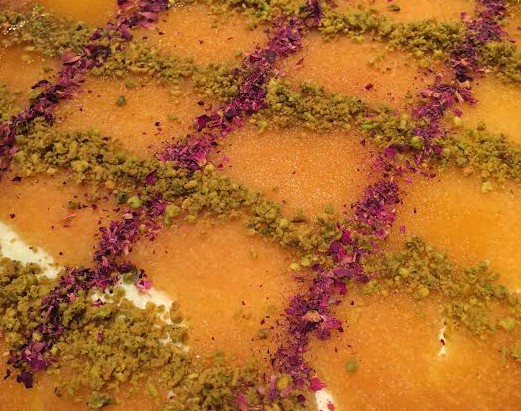
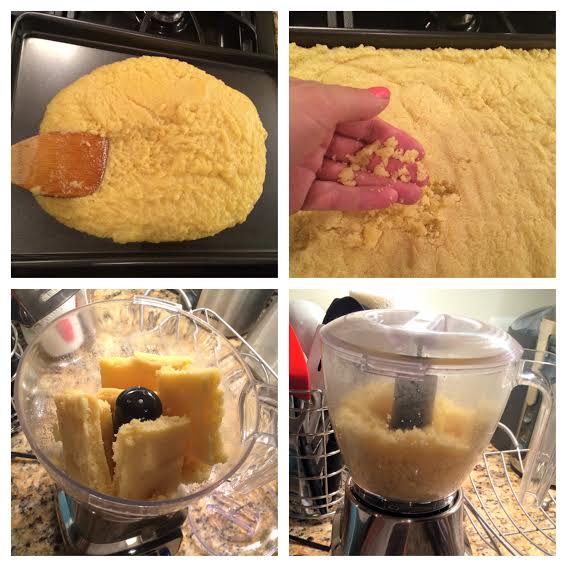
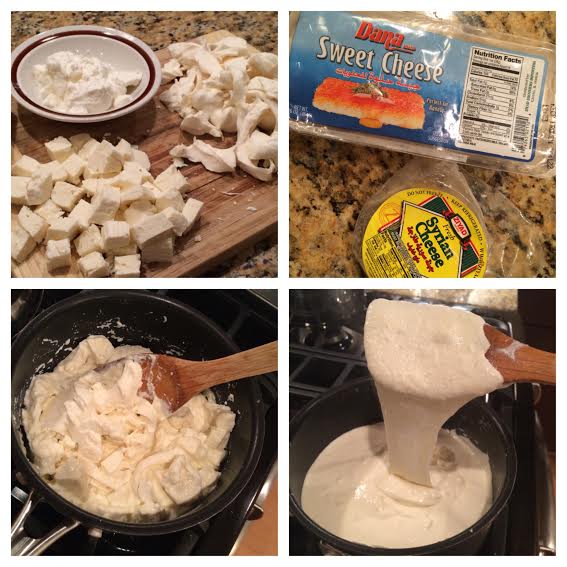
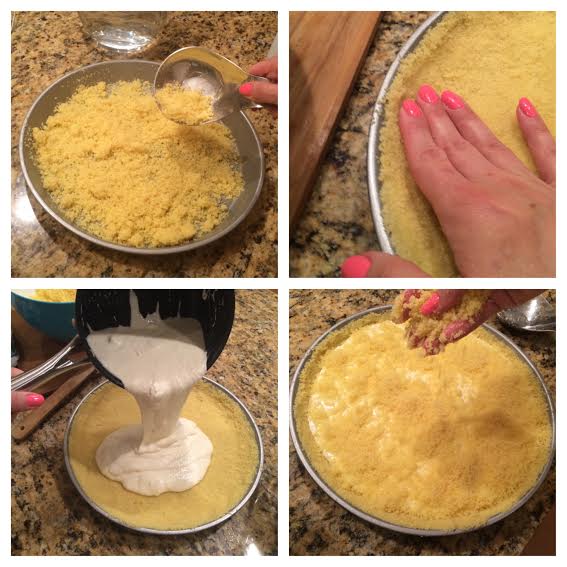
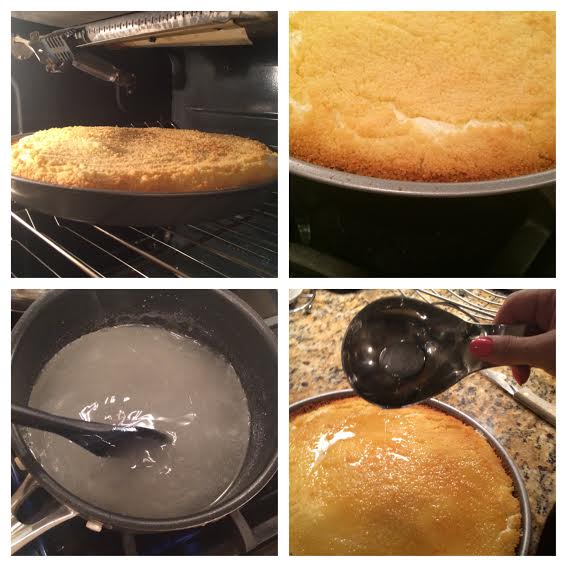
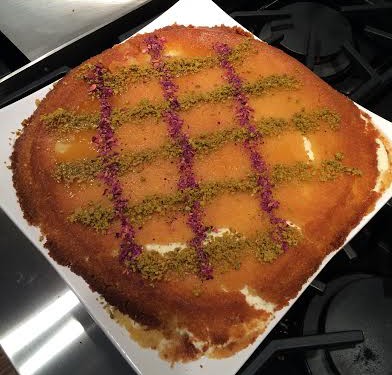
I have made this recipe three times now. My family, a mixture of Lebanese , Palestinian, American and Syrian all love it. They day it tastes like home. We absolutely love it.
Great recipe no one explained it like you guys thank you